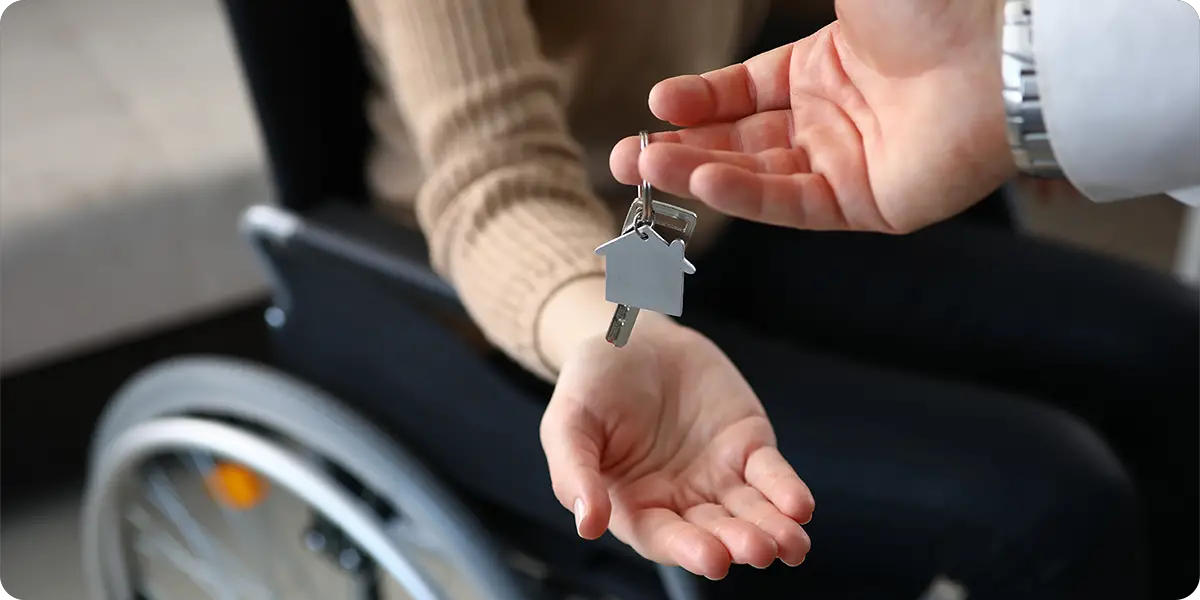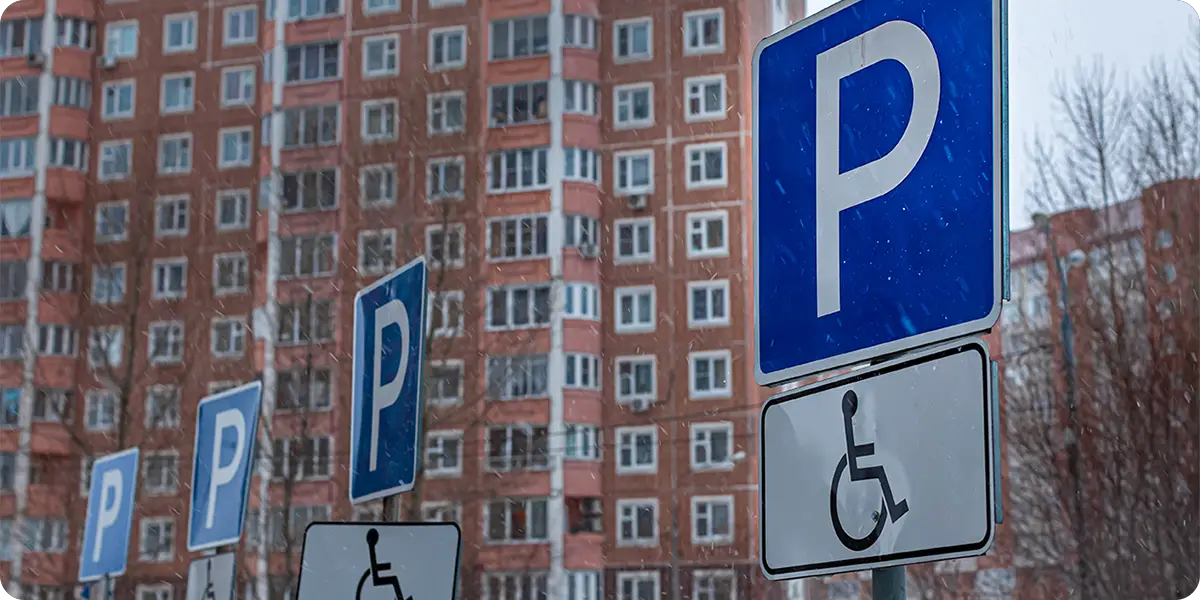By Nathan Brunet on March 28th, 2024

Renters with disabilities often have trouble finding apartments they can afford. There are many types of programs nationwide that assist persons with disabilities. This assistance includes low-income housing for renters with disabilities, as well as accommodations and services.
This easy-to-read guide has all the information that renters with low incomes and disabilities need to know to find affordable housing with features and services for independent living.
If you or someone you know is looking for affordable housing for renters with disabilities, start by exploring the available housing programs:
Mainstream and NED Vouchers
In many areas, special Section 8 Housing Choice Vouchers may be available for households who have a non-elderly member with a disability. This means that they must be between the age of 18-61, and have a documented disability.
These vouchers can be used to rent an apartment in the private market, just like Section 8 vouchers. Tenants pay 30% of their monthly income towards the rent, with HUD rental assistance covering the rest.
There are two different voucher programs for persons with disabilities, and each have different requirements based on the type of household:
Section 811 Housing for Persons with Disabilities
The Section 811 Housing for Persons with Disabilities program offers supportive housing to renters with verified disabilities. Developments assisted by the Section 811 program have income-based rent, and supportive services to help tenants live independently. There is no relation between Section 811 units, and the Section 8 HCV program.
The basic requirements for the Section 811 program are:
For more information about this program, read our step-by-step guide: What is Section 811 Supportive Housing for Persons with Disabilities?
Although there are only two federal low-income housing program specifically for renters with disabilities, there are other programs that allow some properties to be reserved for persons with disabilities.
Properties funded through the following programs may be reserved for residents with disabilities:
Public Housing
The Public Housing program is funded by HUD and managed by locally controlled Public Housing Agencies (or housing authorities). These properties receive an operating subsidy that allows tenants to pay 30% of their adjusted monthly income for rent.
For more information, read our step-by-step-guide: What is the Public Housing Program?
Section 8 Project-Based Rental Assistance
Section 8 Project-Based Rental Assistance (PBRA) is managed by private owners, or sometimes housing authorities. Tenants pay 30% of their adjusted monthly income for rent and the program pays the owners the rest of the rent.
For more information, read our step-by-step guide: What is the Section 8 Project-Based Rental Assistance Program?
Low-Income Housing Tax Credit Program
The Low-Income Housing Tax Credit (LIHTC) program gives tax credits to investors who provide capital for rental properties serving low-income households. These properties offer reduced rents affordable to low-income households in the area. In many cases, LIHTC properties include other resources, such as Section 8 Project-Based Rental Assistance, that make them affordable to those with the lowest incomes.
For more information, read our step-by-step guide: What is the Low-Income Housing Tax Credit Program?
Section 515 Rural Rental Housing
Section 515 is a program run by the U.S. Department of Agriculture (USDA) that provides low-interest loans to developers of rental properties serving low-income households in rural areas. These properties often have other federal subsidies, such as Section 521 Rural Rental Assistance or Section 8 Project-Based Rental Assistance.
Many Section 515 properties are only for disabled and senior tenants. You can check with the property’s management to see if it is designated for disabled and senior tenants. You can also ask about accessible units and what rental assistance is available.

Many waiting lists have preferences. Applicants who qualify for waiting list preferences will receive assistance before applicants who do not. Applicants who do not qualify for preferences will usually have a longer wait to receive assistance.
A preference for applicants with disabilities is one of the most commonly listed preferences for affordable housing. However, there are still many waiting lists without a disability preference, or any preferences at all.
It is important to know that preferences are not requirements. Anyone may still apply, even if they do not qualify for any preferences.
Renters with different disabilities may require a range of accommodations so they can apply for and live in affordable housing. Housing providers who receive federal funds must make reasonable accommodations to ensure that all people, regardless of disability, can apply for their programs and have full enjoyment of their units if selected.
A reasonable accommodation is a change in a rule, policy, practice, or service that may be necessary to allow a disabled person the equal opportunity to use and enjoy the dwelling.
Under federal civil rights laws, a person with disabilities is one who:
Here are the different types of accommodations for low-income renters with disabilities or impairments.
Applicant Accommodations
Reasonable accommodations must be provided for disabled persons in the application process.
Application forms should have information about how to request assistance in completing the application.
Reasonable accommodations could include allowing a service animal to be present for applicant interviews, assistance completing forms, or translation services for persons with Limited English Proficiency.
Unit and Property Accommodations
Renters with disabilities can also request reasonable accommodations in public spaces and in their units. Some examples include a dedicated handicapped parking space, a lower mailbox for someone in a wheelchair, adding grab bars in a bathroom, or allowing a service animal in a building that does not allow pets.
For buildings first occupied after March 1991 with four or more units and an elevator, federal accessibility requirements provide a number of benefits to renters with disabilities:
Caregiver Accommodations
HUD allows some additional services in federally assisted housing for tenants who have difficulty with one or more daily life activities. HUD regulations allow a live-in aide or caregiver to assist tenants with these needs, promoting an assisted living environment.
HUD defines a live-in aide as someone who lives with a disabled person and is essential to the care and wellbeing of the person. They are not obligated to support the person with disabilities and would not be living in the unit except to provide the necessary supportive services.
Caregivers may provide both physical assistance, such as help with bathing or getting in and out of a wheelchair, and cognitive assistance, such as reminders to take medications or supervising meal preparation.
A tenant with a demonstrated need for 24-hour assistance can qualify for a larger unit to provide quarters for a caregiver. For example, a single tenant would normally qualify for either a studio or one-bedroom apartment. If they qualify for a live-in aide, they are eligible for a two-bedroom unit.
Live-in aides do not count as part of the household for calculating income eligibility. They can be removed or evicted by the housing authority or property management for infractions the same as any other tenant, such as for drug- or criminal-related activity. Live-in aides also do not have a right to remain in the unit after the disabled tenant has moved out.

HUD also provides support for other services that help persons with disabilities living in federally subsidized housing. In addition, there are local networks for low-income persons with a variety of needs in most communities nationwide.
Congregate Housing Services Program
HUD’s Congregate Housing Services Program (CHSP) funds meals and other supportive services for frail elderly and non-elderly disabled residents of federally subsidized housing. It also supports meal delivery and non-medical supportive services that help residents maintain independent living.
Properties must offer at least one hot meal per day.
Many Public Housing, Section 8 Project-Based Rental Assistance, Section 202 and Section 515 properties dedicated to serving seniors and disabled residents participate in this program. You can check with the owner or property manager to see if they receive CHSP funds and what services are provided.
Service Directories for Various Disability Networks
The Administration on Disabilities (AoD) works with states, communities and other disability network partners. AoD is part of the Administration for Community Living, which is within the U.S. Department of Health and Human Services (HHS).
Visit the AoD website for information about programs that link people with various disabilities to resources and supports that help them live independently.
Service Resources for Persons with Chronic Mental Illness
The National Alliance on Mental Illness (NAMI) is a nonprofit organization that serves people nationwide with mental illness. It engages in education and advocacy on behalf of mentally ill people at local, state and national levels.
NAMI has a toll-free helpline where staff can answer questions and provide referrals regarding symptoms and treatment options, local support groups and services, education programs, programs to help find jobs and legal services referrals.
Applying for housing with bad credit.
Most HUD housing programs, like Section 8 and Public Housing, do not have a credit check. But Section 8 landlords will likely require one for an available unit.Marla Senter says:
"Affordable Housing Online is the most cohesive and correct information on housing out there online or off."